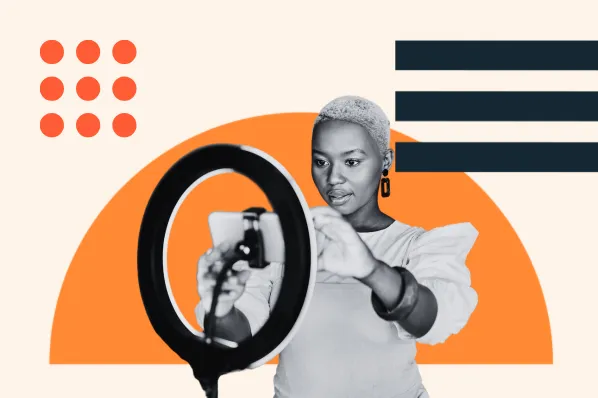Table of Contents
What is social selling?
Social selling involves leveraging social media platforms to expand your pool of prospects, opportunities, and information. It includes identifying, engaging with, nurturing, and converting potential customers and target audience members on platforms like LinkedIn, Facebook, and X.
An important distinction to make is that social selling is not social media marketing.
Social mediamarketing involves using social platforms to promote your brand, products, or services to a broad audience.
For example, I might run a paid ad campaign on Facebook to increase awareness about my new product line. This approach would be more about reaching as many people as possible and driving traffic to my website.
On the other hand, social selling is about relationship-building and engaging with potential customers directly on social media. For example, I might connect with a prospect onLinkedIn, share high-quality content related to their industry, and engage in conversations to better understand their needs. This method is more personalized and aims to establish trust that can eventually lead to sales.
Why is social selling important?
According to Kepios, 5.07 billion people use social media globally as of April 2024. That’s 62.6% of the world’s population!
With that impressive stat in mind, think about how many qualified prospects are already interacting and engaging on these platforms. The best part? You already have access to all of these social networks. You just need to know how to effectively reach and connect with your audience.
Take it from Jose Martins, sales manager at Datadog and former HubSpot business development manager, who incorporates social selling in his workflow:
“It can be as simple as retweeting, sharing a post on LinkedIn about a partner’s Demo Day, or sharing or commenting on a customer’s Funding Rounds latest post/information. The key is to genuinely be passionate about helping others and knowing in the long run, you’ll reap what you sow.”

Our 2023 Social Selling survey shows that 87% of retailers who use social selling find it effective, while 38% say it’s very effective. To emphasize this point, let me share some of the benefits of social selling training before discussing the best courses I’ve come across.
Benefits of Social Selling Training for Reps
Our survey reveals that the top benefits of social selling include brand awareness, increased customer interaction, and precise audience targeting. Enrolling your sales reps in a social selling program can help them gain the knowledge they need to:
- Drive organic traffic to your website and content.
- Increase engagement on the social platforms where your target audience members are active.
- Boost your lead generation efforts.
- Build deeper connections and relationships with prospects.
- Meet qualified leads where they are.
- Show your target audience that your brand cares about the same type of content they do.
- Tailor your current content so it resonates with your audience to get more engagement.
Best Social Selling Training Courses for Sales Reps
As a marketing professional, I’ve participated in many marketing and sales training programs.
So, I’ll share some of the best social selling courses to enroll your sales team members so they can develop the skills they need to engage with prospects and build meaningful relationships.
1. Social Media Marketing Course by HubSpot Academy

Not to toot our own horn, but HubSpot Academy’s free Social MediaMarketing Course is one of the best for sales professionals who want to broaden their social selling skills. The course has nine lessons, 38 videos, and 29 quizzes and takes a little over five hours to complete.
It’s also available in five languages: English, German, Spanish, Japanese, and French.
What stands out to me the most is how comprehensive and well-structured the program is. It covers everything from developing a social media strategy to effectively using platforms like Facebook, Instagram, LinkedIn, and X for advertising.
Why I like it: I love this course because of its practical, hands-on approach with real-world examples and actionable insights. The instructors (Crystal King, Dayne Topkin, and Corey Braccialini) are engaging and make complex concepts relatively easy to understand.
In particular, I like how King elaborates on key social selling topics like:
- Using social media listening and monitoring.
- Building one-on-one relationships.
- Measuring your social media ROI.
Also, you get a social media marketing certificate from HubSpot, which adds value to your professional profile.
Pro tip: Download our free guide, 51 Tips forSocial SellingonLinkedInand Beyond. It will help you further improve your social selling skills.
2. Social Selling Certification Course by Hootsuite

Hootsuite’sSocial SellingCertification Course offers five lessons that total around two hours. Once you complete it, you must pass a timed online exam to receive a certificate.
The course is excellent for beginners and intermediate social media marketers. It offers actionable advice that beginners might find helpful, such as how to optimize your LinkedIn profile and use CRM data to engage with leads.
Why I like it: I’m impressed with how the course seamlessly integrates with Hootsuite’s social media management tools, which enhances the learning experience.
However, my least favorite aspect is that the course is priced at $299, which might be too much for some people. I also find the course a bit basic for social media experts who want more advanced social selling tips.
Other than that, I recommend checking out this course to get certification from Hootsuite. Since the brand is a well-recognized name in the social media management space, the certificate can add credibility to your personal brand.
3. Social Selling Training Course by MTD

MTD’sSocial Selling Training course focuses on LinkedIn as a powerful tool for social selling. The course covers a lot, including maximizing your LinkedIn profile and using your network to build other professional contacts. I recommend this course to businesses that want their sales reps to learn how to use LinkedIn to network and sell.
That said, the course price isn’t revealed on MTD’s website, but I understand why that’s the case since the cost depends on:
- The delivery method (virtual, face-to-face, or both).
- The number of days you need to cover the course.
- How many learners you register.
Why I like it: I love the course’s flexible training approach. I can attend it as an in-house workshop, a live webinar, or both, which allows me to tailor the learning experience to my team’s needs and schedules.
4. Corporate Social Selling Training Program by Digital Marketing Institute (DMI)
..webp?width=650&height=271&name=social%20selling%20training_Corporate%20Social%20Selling%20Training%20Program%20by%20Digital%20Marketing%20Institute%20(DMI)..webp)
DMI’s CorporateSocial Selling Training Program impresses me with its interactive learning, dynamic videos, and practical exercises that offer a hands-on experience.
The course has five modules taught by DMI specialists:
- What is social selling?
- The art of targeting.
- Tools of attraction.
- Increasing engagement.
- Closing and retaining.
After you complete the course, you’ll receive a certificate. However, you must first pass a 60-minute test that includes image- and text-based multiple-choice and hot spot questions.
I also noted that the course lasts five to six hours, so you must program your time well to complete it.
Why I like it: The lessons are bite-sized (10 to 20 minutes each), making them easier to digest and fit into a busy schedule. The learning platform’s interface is intuitive and seamless, which makes exploring the lessons easy.
5. Social Selling with LinkedIn

The Social SellingwithLinkedIn course has four chapters covering topics like creating a buyer-centric LinkedIn profile and engaging with buyers and decision-makers.
With a one-time fee of $29.99, the course is quite affordable for most people, and you receive a certificate once you complete it.
Why I like it: The social selling course caught my attention because of its many positive reviews, and I can see why. The program is short, beginner-friendly, and packed with value. In just 28 minutes, Gabe Villamizar, a business-to-business (B2B) marketing expert, explains the basics of social selling and how to build your personal brand on LinkedIn.
6. Social Selling Mastery Course by SOCO

SOCO’sSocial SellingMastery course attracted me due to the amount of detail the landing page provides before you enroll. The page even has photos of previous in-person sessions, which enticed me to take a look at the program.
It covers the following social selling topics:
- Creating social media profiles that entice buyers.
- Generating leads on LinkedIn.
- Using hashtags for prospecting.
- Establishing yourself as an authority on social media.
- Adding social media to your sales process.
- Using content to stay top of mind with customers and prospects.
- Closing deals faster using technology.
You can attend the course in two ways: in-person workshops that last from half a day to a full day or multiple 180-minute virtual instructor-led training sessions. Once you complete the program, you get a certificate.
Why I like it: I love that the course offers in-person training and virtual instructor-led teaching. As a result, I can choose the method that best suits my schedule.
However, I noticed that the pricing information isn’t straightforward, and you may need to contact their support team for a quote. Alternatively, you can purchase the e-course for one year at $299.
Social Selling Pro Tips
Now, let me share some social selling strategies you need to remember as you train your sales reps.
1. Provide education on the three C’s of social selling.
When training our sales team, I always include the three C’s of social selling.
First, we have Context. I ensure our reps establish context around who they are and their purpose on social media by maintaining their profiles and identifying, engaging with, and establishing solid relationships with qualified prospects.
Next, we focus on Content. Our sales team shares valuable content with prospects and followers on social media. This content may include images, videos, ebooks, articles, and infographics. They can also repost user-generated content featuring our products to increase brand awareness. In fact, HubSpot found that 92% of retailers find this strategy effective, while 47% find it very effective.
Lastly, we have Collaboration. I maintain open lines of communication between all our sales reps so they can leave a consistent and on-brand impact on prospects that feels professional, thoughtful, and valuable.
2. Promote rep-to-prospect connections and interactions on social media.
As a marketing manager, I know the importance of building relationships with prospects. It’s the only way to promote trust and familiarity between myself and my prospects.
When I take time to get to know and interact with leads on social media, they see that I care about them on a personal level, value their opinions, and want to support them. For these reasons, I encourage our sales reps to connect and interact with prospects on social platforms, as it will naturally lead to deeper bonds.
In my case, I interact with followers by:
- Reacting to their posts and responding to their comments.
- Sharing content with them via posts or direct messages.
- Sharing or re-sharing their content or posts.
- Allowing them to connect with one of our internal experts on a topic they mention they’re interested in or struggling with.
- Connecting with them outside of social media so we can have a deeper discussion about a topic (e.g., over Zoom or a phone call).
Colleen Reilly, a midmarket account executive at HubSpot and CEO of Prezence, says the following about her use of LinkedIn and Vidyard for social selling and prospecting:

Aditya Kumar, former head of Growth and Partnerships in SEA & India (HubSpot for Startups), also likes to initiate and foster connections with prospects on LinkedIn and X.
He says, “I use short videos on LinkedIn and X (more so on LinkedIn) to bridge elements of trust, branding, and engagement. For instance, on some posts, I’ve received over 50 RSVPs for a webinar. This content also attracts other folks already on these social channels and could be a good fit for my partnerships, networks, or startup founders whom I can link up with.”
Here’s an example of one of Kumar’s LinkedIn videos:

This example shows how building those connections with prospects on social media can lead to success on a larger scale.
3. Introduce reps to your social personas so they know whom to target.
My social personas are very similar to my buyer personas. The only difference is that my social personas are my buyer personas on social media.
Here are some questions I ask myself while creating my social media buyer personas:
- Which platforms are my personas active on the most?
- Which types of posts are my personas interacting and engaging with the most?
- What types of content do my personas want to see, engage with, and share on social networks?
- What vocabulary is most appealing to my audience on social media?
- What needs, wants, and challenges of my prospects can I resolve on social platforms?
- How would my followers want sales reps to approach them on each platform?
Pro tip: Use HubSpot’s Make My Persona tool to create your social personas. It will help you create a persona that highlights what makes your target market unique.
I also tap into my current audience by sharing a survey to ask how they spend their time on different platforms and what type of social content is most valuable to them. This way, I clearly understand which platforms they prefer so I can focus my efforts on where they’re most likely to engage. It also helps me tailor my content strategy to better meet their interests and needs, which leads to higher engagement rates.
Another strategy I like to use is to look at my competitors’ content, posting frequency, and interactions on their social accounts. By doing so, I gain insights into what type of content generates the most interest and discussion and gather ideas for posts that resonate with our shared target audience.
Train Your Sales Reps for Social Selling Success
It’s clear that social selling is no longer optional — it’s a must. Traditional sales methods like cold calling and cold emailing alone won’t cut it.
That said, for your sales team to succeed, they must get the proper training. The social selling training courses I’ve shared can give your reps the fundamental skills they need to build deeper connections with prospects.
Implement the tips I’ve shared and watch your salespeople turn their social media interactions into meaningful business relationships.
Editor's note: This post was originally published in October 2020 and has been updated for comprehensiveness.
Social Selling



![LinkedIn for Social Selling: How to Research, Prospect, & Sell on Platform [+ New Data]](https://53.fs1.hubspotusercontent-na1.net/hubfs/53/copy%20of%20jade%20walters%20btb%20(40).png)




-3.png)



